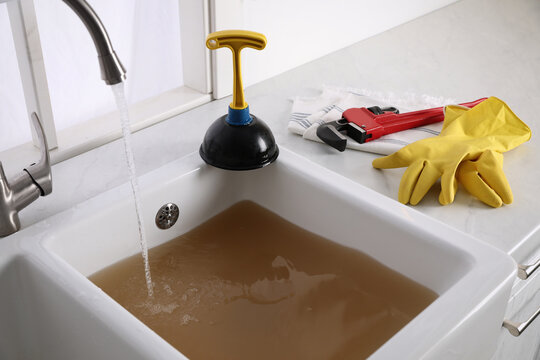Successful Plunger and Drain Cleaner Methods: Key Practices
Successful Plunger and Drain Cleaner Methods: Key Practices
Blog Article
What are your thoughts on A Guide to Plungers (and How to Use Them)?

Intro
Appropriate maintenance of household drains pipes is vital for preventing blockages and ensuring smooth water flow. Among the trick tools in every property owner's toolkit is the bettor, along with various drain cleaners developed to deal with stubborn blockages successfully. This short article explores how to utilize plungers and drain cleaners efficiently to keep your drains moving openly.
Area 1: Comprehending Plungers
Kinds of Plungers
There are a number of types of bettors readily available, each created for different types of drains pipes and blocks. One of the most typical kinds include cup plungers, flange plungers, and accordion bettors.
How Plungers Work
Plungers deal with the principle of creating stress and suction to displace blockages. When appropriately used over a drainpipe, they develop a vacuum cleaner that can take out debris or separate blockages.
Picking the Right Plunger
Choosing the best bettor depends on the kind of drainpipe and the nature of the blockage. Mug plungers are suitable for sinks and bathtubs, while flange plungers are much better matched for toilets because of their style.
Common Errors with Bettors
Staying clear of these blunders ensures effective plunging: improper seal around the drainpipe, inadequate force, and not clearing bordering particles.
Area 2: Using Plungers Efficiently
Prep work
Prior to diving, make certain the plunger covers the drain completely and creates a limited seal. Clear any visible debris around the drain opening.
Method
Begin with gentle plunging motions to build suction. Increase pressure slowly, utilizing a consistent rhythm. Repeat as needed up until the drain gets rid of.
Fixing Tips
If plunging doesn't work, attempt adjusting the seal, using oil jelly for a much better seal, or utilizing a different type of bettor.
Area 3: Comprehending Drain Cleansers
Types of Drain Cleaning Company
Drain pipes cleansers can be chemical or enzymatic. Chemical cleansers make use of strong chemicals to liquify blockages, while chemical cleansers make use of all-natural enzymes to break down raw material.
Exactly How Drainpipe Cleaning Company Job
Chemical cleansers react with obstructions to dissolve them, while chemical cleaners break down organic products like hair and oil without hurting pipelines.
Safety Considerations
Constantly put on gloves and eye security when making use of chemical drain cleaners. Make certain adequate ventilation and comply with supplier instructions very carefully.
Eco-Friendly Alternatives
Take into consideration making use of vinegar and baking soda or enzyme-based cleaners for environmentally friendly choices that are much safer for pipes and the environment.
Section 4: Using Drain Cleaning Company Properly
Application Strategies
Put chemical cleaners directly into the drain opening. Permit them to benefit the recommended time before purging with warm water. Chemical cleansers should sit overnight.
Safety measures
Stay clear of blending various sorts of cleansers, as this can produce toxic fumes. Never use chemical cleaners along with a plunger, as splashing can happen.
Handling Stubborn Obstructions
For relentless blockages, think about using a plumbing serpent or calling a professional plumbing professional to avoid damages to pipes.
Final thought
Finally, understanding how to utilize bettors and drain cleaners efficiently is crucial for maintaining healthy plumbing systems. By selecting the right devices and strategies, home owners can tackle minor clogs and prevent major plumbing concerns down the line.
How To Properly Use A Plumbing Snake To Clear Drains
When any drain clogs in our home arise, we tend to gravitate toward the plunger and little else. In cases where the plunger and its vacuum-created pressure are not able to clear clogs, many immediately move to harmful chemicals or simply call their plumber to fix the issue.
we’re happy to help with all drain cleaning needs and concerns. This includes informing you on a few other home remedies you may have at your disposal for minor to moderate clogs, one of which is the use of a plumbing snake. Many people have never used one of these before – let’s go over the steps to take when your drain clogs and you have a plumbing snake available.
Attempt Plunger Use
The first step here, as we noted above, should indeed be to grab your plunger when you notice a drain clog and attempt to resolve it this way. If you’re unsure how to use a particular type of plunger, our plumbers can answer any questions you have. If this doesn’t do the trick, however, you move on to the snake.
Locate And Prepare Snake
A plumbing snake is a metal or plastic device that’s generally about a quarter of an inch thick. It’s design with significant extensions, meant to reach down into your clogged drain and push the clog out. Snakes also contain drain augers that will latch onto and push stubborn blockages.
If your plunger doesn’t clear a clog, locate your snake and bring it to the drain in question. We also recommend keeping a bucket nearby to collect the clog once you pull it out, plus we’d advise wearing goggles and possibly protective gloves.
Feed Snake
Once you’re ready to go, feed the snake slowly down the drain, using the crank device it comes with to keep it moving until it finds the clog. Once this happens, much of the clog will be latched onto the coil so you can pull it out, while the rest will simply break up and flow downward.
Detach Debris
Remove the snake slowly from the drain, and once you’ve done so, pick off any debris that’s stuck to the coil. This is another area where wearing gloves is a must.
Flush Drain
Finally, take a few minutes to ensure the snake has done its job correctly. If you’ve been using it on a toilet, flush the toilet a couple times and make sure everything flows well. If you’ve used it on a different drain, flush it with some room temperature water.
https://www.mybuddytheplumber.com/blog/how-to-properly-use-a-plumbing-snake-to-clear-drains/

Application Strategies
Put chemical cleaners directly into the drain opening. Permit them to benefit the recommended time before purging with warm water. Chemical cleansers should sit overnight.
Safety measures
Stay clear of blending various sorts of cleansers, as this can produce toxic fumes. Never use chemical cleaners along with a plunger, as splashing can happen.
Handling Stubborn Obstructions
For relentless blockages, think about using a plumbing serpent or calling a professional plumbing professional to avoid damages to pipes.
Final thought
Finally, understanding how to utilize bettors and drain cleaners efficiently is crucial for maintaining healthy plumbing systems. By selecting the right devices and strategies, home owners can tackle minor clogs and prevent major plumbing concerns down the line.
How To Properly Use A Plumbing Snake To Clear Drains
When any drain clogs in our home arise, we tend to gravitate toward the plunger and little else. In cases where the plunger and its vacuum-created pressure are not able to clear clogs, many immediately move to harmful chemicals or simply call their plumber to fix the issue.
we’re happy to help with all drain cleaning needs and concerns. This includes informing you on a few other home remedies you may have at your disposal for minor to moderate clogs, one of which is the use of a plumbing snake. Many people have never used one of these before – let’s go over the steps to take when your drain clogs and you have a plumbing snake available.
Attempt Plunger Use
The first step here, as we noted above, should indeed be to grab your plunger when you notice a drain clog and attempt to resolve it this way. If you’re unsure how to use a particular type of plunger, our plumbers can answer any questions you have. If this doesn’t do the trick, however, you move on to the snake.
Locate And Prepare Snake
A plumbing snake is a metal or plastic device that’s generally about a quarter of an inch thick. It’s design with significant extensions, meant to reach down into your clogged drain and push the clog out. Snakes also contain drain augers that will latch onto and push stubborn blockages.
If your plunger doesn’t clear a clog, locate your snake and bring it to the drain in question. We also recommend keeping a bucket nearby to collect the clog once you pull it out, plus we’d advise wearing goggles and possibly protective gloves.
Feed Snake
Once you’re ready to go, feed the snake slowly down the drain, using the crank device it comes with to keep it moving until it finds the clog. Once this happens, much of the clog will be latched onto the coil so you can pull it out, while the rest will simply break up and flow downward.
Detach Debris
Remove the snake slowly from the drain, and once you’ve done so, pick off any debris that’s stuck to the coil. This is another area where wearing gloves is a must.
Flush Drain
Finally, take a few minutes to ensure the snake has done its job correctly. If you’ve been using it on a toilet, flush the toilet a couple times and make sure everything flows well. If you’ve used it on a different drain, flush it with some room temperature water.
https://www.mybuddytheplumber.com/blog/how-to-properly-use-a-plumbing-snake-to-clear-drains/

As an enthusiastic reader about , I was thinking sharing that piece of content was sensible. Do you know about somebody who is in to How To Use Your Toilet Plunger Correctly in 5 Easy Steps? Be sure share it. Thank you for being here. Please check our site back soon.
Visit My Site Report this page